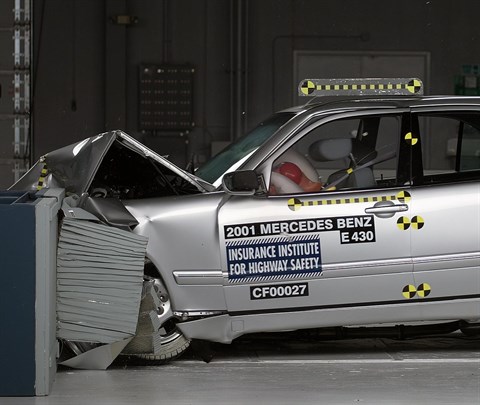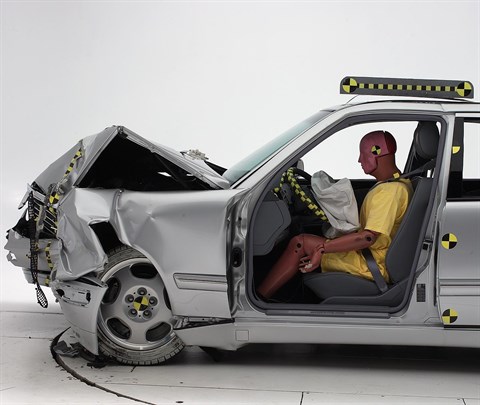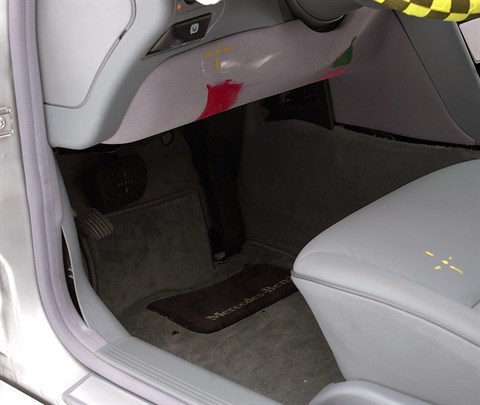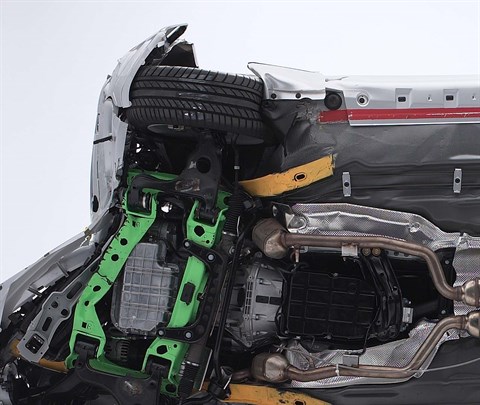Moderate overlap front: original test
Rating applies to 2000-02 models built after January 2000
Tested vehicle: 2001 Mercedes-Benz E 430 4-door
The Mercedes E class was redesigned for the 1996 model year.
All 1997 and later E class models manufactured after January 1997 include structural changes to improve occupant protection in frontal crashes. Additional structural changes were made beginning with 2000 E class models manufactured after January 2000 (note: information about when a specific vehicle was manufactured is on the certification label typically affixed to the car on or near the driver door).
| Evaluation criteria | Rating |
|---|---|
| Overall evaluation | |
| Structure and safety cage | |
| Driver injury measures | |
| Head/neck | |
| Chest | |
| Leg/foot, left | |
| Leg/foot, right | |
| Driver restraints and dummy kinematics | |

Action shot taken during the frontal offset crash test.

The dummy's position in relation to the steering wheel and instrument panel after the crash test indicates that the driver's survival space was maintained well.

Intrusion into the driver's space was minimal, and all leg and foot injury measures were low.

A strong safety cage helped keep the tire out of the driver footwell area, maintaining the integrity of the occupant compartment. Crumpled structure in front of the occupant compartment indicates where the crash energy was absorbed.
Rating applies to 1997-2000 models built after January 1997 and before February 2000
Tested vehicle: 1997 Mercedes-Benz E 420 4-door
The Mercedes E class was redesigned for the 1996 model year. All 1997-2000 E class models manufactured after January 1997 but before February 2000 include structural changes to improve protection in frontal crashes. Additional structural changes were made beginning with the 2000 E class models manufactured after January 2000, so the listed ratings do not apply to the latest models (note: information about when a specific vehicle was manufactured is on the certification label typically affixed to the car on or near the driver door).
The Insurance Institute for Highway Safety has evaluated the crashworthiness of of a 1997 model E 420 with the first set of structural changes in a 40 mph frontal offset crash test into a deformable barrier.
| Evaluation criteria | Rating |
|---|---|
| Overall evaluation | |
| Structure and safety cage | |
| Driver injury measures | |
| Head/neck | |
| Chest | |
| Leg/foot, left | |
| Leg/foot, right | |
| Driver restraints and dummy kinematics Dummy movement wasn't well controlled. During rebound, the dummy's head hit the window sill. There was too much upward movement of the steering wheel. Late in the crash, the driver door opened. This opening didn't significantly affect dummy movement during the test but shouldn't happen because, in some crashes, it could allow partial or complete occupant ejection. | |

Action shot taken during the frontal offset crash test.

Despite some buckling of the roof rail, the dummy's survival space was maintained well. However, this good performance was marred by the opening of the driver door.

Energy-absorbing padding between the footwell and floor carpet is designed to reduce forces on drivers' legs in serious frontal crashes.

The driver door opened, which could allow occupant ejection in some crashes.
